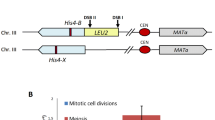Summary
Nonreciprocal recombination (gene conversion) between homologous sequences at nonhomologous locations in the genome occurs readily in the yeast Saccharomyces cerevisiae. In order to test whether the rate of gene conversion is dependent on the number of homologous copies available in the cell to act as donors of information, the level of conversion of a defined allele was measured in strains carrying plasmids containing homologous sequences. The level of recombination was elevated in a strain carrying multiple copies of the plasmid, compared with the same strain carrying a single copy of the homologous sequences either on a plasmid or integrated in the genome. Thus, the level of conversion is proportional to the number of copies of donor sequences present in the cell. We discuss these results within the framework of currently favoured models of recombination.
Similar content being viewed by others
References
Boeke JD, Xu H, Fink GR (1988) A general method for the chromosomal amplification of genes in yeast. Science 239:280–282
Boeke JD, Lacroute F, Fink GR (1984) A positive selection for mutants lacking orotidine-5′-phosphate decarboxilase activity in yeast. Mol Gen Genet 197:345–346
Botstein D, Falco SC, Stewart SE, Brennan M, Scherer S, Stinchcomb DT, Struhl K, Davis RW (1979) Sterile host yeast (SHY): a eukaryotic system of biological containment for recombinant DNA experiments. Gene 8:17–24
Edelman GM, Gally JA (1970) Arrangements and evolution of eukaryotic genes. In: Schmitt FO (ed.) The Neurosciences. Second study programa. Rockefeller University Press, New York, pp. 962–972
Esposito MS, Wagstaff JE (1981) Mechanisms of mitotic recombination. In: Strathern J, Jones EW, Broach JR (eds). The molecular biology of the yeast Saccharomyces. Cold Spring Harbor Laboratory Press, Cold Spring Harbor, New York, pp. 341–370
Falco SC, Li Y, Broach R, Botstein D (1982) Genetic consequences of chromosomally integrated 2 μ plasmid DNA in yeast. Cell 29:573–584
Falco SC, Rose M, Botstein D (1983) Homologous recombination between episomal plasmids and chromosomes in yeast. Genetics 105:843–856
Fogel S, Mortimer RK, Lusnak K (1981) Mechanisms of meiotic gene conversion, or “wanderings on a foreign strand”. In: Strathern J, Jones EW, Broach JR (eds). The molecular biology of the yeast Saccharomyces. Cold Spring Harbor Laboratory Press, Cold Spring Harbor, New York, pp. 289–339
Haber JE, Leung WY, Borts RH, Lichten M (1991) The frequency of meiotic recombination in yeast is independent of the number and position of homologous donor sequences: Implications for chromosome pairing. Proc Natl Acad Sci USA 88:1120–1124
Jinks-Robertson S, Petes TD (1986) Chromosomal translocations generated by high frequency meiotic recombination between repeated yeast genes. Genetics 114:731–752
Kupiec M, Petes TD (1988) Meiotic recombination between repeated transposable elements in Saccharomyces cerevisiae. Mol Cell Biol 8:2942–2954
Lea DE, Coulson CA (1948) The distribution of the number of mutants in bacterial populations. J Genet 49:264–284
Lichten M, Borts RH, Haber JE (1987) Meiotic crossing over and gene conversion between dispersed homologous sequences occur frequently in Saccharomyces cerevisiae. Genetics 115:233–246
Ma H, Kunes S, Schatz PJ, Botstein D (1987) Plasmid construction by homologous recombination in yeast. Gene 58:201–216
Maniatis T, Fritsch EF, Sambrook J (1982) Molecular cloning: a laboratory manual. Cold Spring Harbor Laboratory Press, Cold Spring Harbor, New York
Melamed C, Nevo Y, Kupiec M (1992) Involvement of cDNA in homologous recombination between Ty elements in Saccharomyces cerevisiae. Mol Cell Biol 12:1613–1620
Meselson M, Radding C (1975) A general model for genetic recombination. Proc Natl Acad Sci USA 72:358–361
Petes TD, Hill CW (1988) Recombination between repeated genes in microorganisms. Annu Rev Genet 22:147–168
Radding CM (1982) Homologous pairing and strand exchange in genetic recombination. Annu Rev Genet 16:405–437
Sherman F, Fink GR, Hicks JB (1986) Methods in yeast genetics. Cold Spring Harbor Laboratory Press, Cold Spring Harbor, New York
Sun H, Treco D, Szostak JW (1991) Extensive 3′-overhanging, single-stranded DNA associated with the meiosis-specific double-strand breaks at the ARG4 recombination initiation site. Cell 64:1155–1161
Szostak JW, Orr-Weaver TL, Rothstein RJ, Stahl FW (1983) The double strand-break model for recombination. Cell 33:25–35
Author information
Authors and Affiliations
Additional information
Communicated by P.C. Hollenberg
Rights and permissions
About this article
Cite this article
Melamed, C., Kupiec, M. Effect of donor copy number on the rate of gene conversion in the yeast Saccharomyces cerevisiae . Molec. Gen. Genet. 235, 97–103 (1992). https://doi.org/10.1007/BF00286186
Issue Date:
DOI: https://doi.org/10.1007/BF00286186




